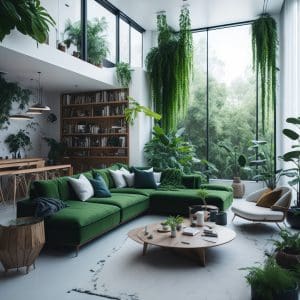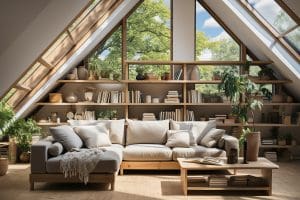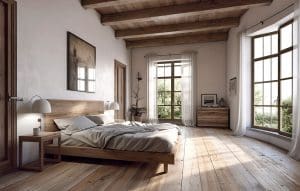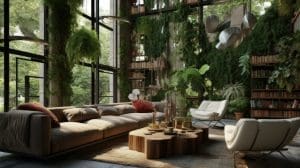
7 Health Benefits of Biophilic Home Design
Do you experience a sense of calm when you’re out camping, taking a brisk walk through the park, or even looking at a pastoral painting? It’s not a coincidence. It’s your love of life, also known as biophilia.
Biophilic design theorizes humans have “an innate biological affinity for the natural environment.” Multiple observational studies have shown positive correlations between associating with nature and your mood and overall health. Some long-term effects include decreased levels of anxiety and depression, increased cognitive function, and reduced risk of chronic diseases.
 Biophilia is ingrained in our DNA. It makes sense when you think about it. Many of our calming activities involve nature to some degree, whether it’s gardening, lying out in the sun, or sipping coffee by the windowsill.
Biophilia is ingrained in our DNA. It makes sense when you think about it. Many of our calming activities involve nature to some degree, whether it’s gardening, lying out in the sun, or sipping coffee by the windowsill.
With biophilic design, you can incorporate your organic connection with nature in your home. In this post, we’ll briefly explore some key features and principles of biophilic home design, then dive into seven of its many health benefits.
Features of Biophilic Home Design
Biophilic home design is an architectural and interior design approach that evokes or replicates the presence of nature. Design and construction companies achieve this in numerous ways, including:
- Natural light: Natural lighting helps you create a
 connection with the outdoors — and the more you can get, the better! Designers achieve this by including sun-facing windows, sliding doors, and skylights.
connection with the outdoors — and the more you can get, the better! Designers achieve this by including sun-facing windows, sliding doors, and skylights. - Natural materials: Incorporating materials like wood, bamboo, and stone in your flooring, furniture, and finishes helps establish your connection with nature, bringing a sense of warmth into your home.
- Natural ventilation: Biophilic homes are designed with airflow in mind. When your space has natural ventilation and air circulation, it can give you more control over your temperature and humidity levels, making your home a more comfortable space to live.
- Natural colors: Earth color palettes, like shades of green, blue, and brown, can evoke a sense of harmony and tranquility.
- Natural patterns: Patterns we associate with nature alsoevoke a sense of harmony and tranquility. Some natural patterns include fractals, organic shapes, and flora and fauna designs.
- Natural scents and sounds: Finding ways to include natural scents and sounds can create a multi-sensory experience and help you connect with nature on a more subliminal level.
- Plants and greenery: Indoorplants improve air quality and breathe life into your home, helping create a sense of well-being. More on this shortly.
Even just incorporating some of these biophilic home design features can improve your overall health. Here’s how:
1. Anxiety and Stress Reduction

More than half of the world’s population lives in urban areas, and studies show that city living and an urban upbringing can impact your neural social stress processing. This is associated with higher rates of stress, anxiety, and depression compared to people growing up in rural areas.
Having contact with natural outdoor settings and elements introduces a sense of calm in your busy everyday life, leading to reduced stress levels. Add natural lighting, materials, patterns, scents, and sounds wherever you can, whenever you can.
2. Faster Healing
 Biophilia reduces stress by putting you in a positive state of mind, which also contributes to faster healing.
Biophilia reduces stress by putting you in a positive state of mind, which also contributes to faster healing.
Hospital studies have shown links between biophilia and improved patient outcomes, including “faster recovery rates, decreased dependency on medication, and improved emotional wellness.” One study found that biophilia can reduce hospital stays by one day, which could save Americans $93 million each year.
3. Improved Air Quality

Indoor plants also improve your indoor air quality through a process called phytoremediation. Here’s how it works:
- First, Plants absorb airborne pollutants through stomata, which are tiny openings on their leaves.
- Next, Plants convert these pollutants by breaking them down and removing them.
- Through photosynthesis, plants then absorb carbon dioxide and release oxygen.
- Finally, plants release water vapor, which increases humidity in the surrounding air and helps with respiratory issues and symptoms associated with dry skin.
4. Improved Cognition and Performance
 Taking breaks from a task can help you rebalance yourself and improve productivity. Many of the best ways to make these improvements are by connecting with nature. Stepping away from your desk and taking a quiet walk, tending to your garden, or laying outside or by your sun-facing window helps give your cognitive functions a well-deserved rest, so they can restore themselves and avoid fatigue.
Taking breaks from a task can help you rebalance yourself and improve productivity. Many of the best ways to make these improvements are by connecting with nature. Stepping away from your desk and taking a quiet walk, tending to your garden, or laying outside or by your sun-facing window helps give your cognitive functions a well-deserved rest, so they can restore themselves and avoid fatigue.
After a few minutes at rest, you’ll be ready to reapproach the task at hand.
5. Increased Creativity and Productivity
Psychologists found that adding plants to your home office or creative space can lead to a:
 47% increase in overall well-being
47% increase in overall well-being - 45% increase in creativity
- 38% increase in productivity
Many reasons for these benefits have already been defined above, including reduced stress and anxiety and improved cognition and performance.
6. Better Sleep Quality
 Biophilic home design improves your sleep quality in numerous ways. Cleaner air
Biophilic home design improves your sleep quality in numerous ways. Cleaner air
makes breathing easier, while the scenery, scents, and smells promote a sense of relaxation by putting your mind at ease. Because biophilic elements reduce stress and anxiety, you’ll be less likely to focus on tomorrow’s tasks and other things going on in your world. Also, natural light during the day helps regulate your sleep-wake cycle, connecting you to your internal circadian rhythms.
7. Increased Well-Being and Engagement

Biophilic home design is inviting by nature because it invites nature into your home. It inspires and connects you to the world, making you feel like a better version of yourself. When you feel good, you’re more likely to engage with your surrounding environment, whether you’re at home, work, or a social function.
You probably wouldn’t think that something as simple as increasing your home’s natural lighting, growing plants indoors, or surrounding yourself with earthy colors can profoundly impact your health and wellness. However, biophilic design can help nurture your well-being and foster a deeper connection with the natural world.
At Pathway, we’re here to help. You're creating a happier, healthier home by letting your house become a place where you can rejuvenate your body, stimulate your mind, and inspire your spirit.
Do you like home remodeling tips?
Remodeling your home can be a daunting experience. The Pathway team has taken the time and expertise to create podcast episodes detailing the tips and tricks of the trade.
